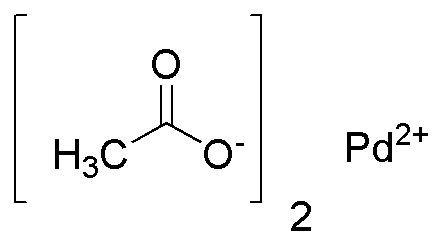Palladium(II) acetate is widely utilized in research focused on:
- Catalysis: It serves as a key catalyst in various organic reactions, including cross-coupling reactions, which are essential in the synthesis of pharmaceuticals and agrochemicals.
- Organic Synthesis: This compound is frequently used in the preparation of complex organic molecules, allowing chemists to create new materials with specific properties, such as polymers and fine chemicals.
- Electronics: In the electronics industry, it is employed in the production of conductive inks and pastes, which are vital for printed circuit boards and flexible electronics.
- Nanotechnology: Palladium(II) acetate is used in the synthesis of palladium nanoparticles, which have applications in catalysis, sensors, and drug delivery systems.
- Analytical Chemistry: It is utilized in various analytical techniques, including mass spectrometry, to enhance the detection of organic compounds, improving the accuracy of chemical analysis.
General Information
Properties
Safety and Regulations
Applications
Palladium(II) acetate is widely utilized in research focused on:
- Catalysis: It serves as a key catalyst in various organic reactions, including cross-coupling reactions, which are essential in the synthesis of pharmaceuticals and agrochemicals.
- Organic Synthesis: This compound is frequently used in the preparation of complex organic molecules, allowing chemists to create new materials with specific properties, such as polymers and fine chemicals.
- Electronics: In the electronics industry, it is employed in the production of conductive inks and pastes, which are vital for printed circuit boards and flexible electronics.
- Nanotechnology: Palladium(II) acetate is used in the synthesis of palladium nanoparticles, which have applications in catalysis, sensors, and drug delivery systems.
- Analytical Chemistry: It is utilized in various analytical techniques, including mass spectrometry, to enhance the detection of organic compounds, improving the accuracy of chemical analysis.
Documents
Safety Data Sheets (SDS)
The SDS provides comprehensive safety information on handling, storage, and disposal of the product.
Product Specification (PS)
The PS provides a comprehensive breakdown of the product’s properties, including chemical composition, physical state, purity, and storage requirements. It also details acceptable quality ranges and the product's intended applications.
Certificates of Analysis (COA)
Search for Certificates of Analysis (COA) by entering the products Lot Number. Lot and Batch Numbers can be found on a product’s label following the words ‘Lot’ or ‘Batch’.
Número de catálogo
Número de lote/lote
Certificates Of Origin (COO)
This COO confirms the country where the product was manufactured, and also details the materials and components used in it and whether it is derived from natural, synthetic, or other specific sources. This certificate may be required for customs, trade, and regulatory compliance.
Número de catálogo
Número de lote/lote
Safety Data Sheets (SDS)
The SDS provides comprehensive safety information on handling, storage, and disposal of the product.
DownloadProduct Specification (PS)
The PS provides a comprehensive breakdown of the product’s properties, including chemical composition, physical state, purity, and storage requirements. It also details acceptable quality ranges and the product's intended applications.
DownloadCertificates of Analysis (COA)
Search for Certificates of Analysis (COA) by entering the products Lot Number. Lot and Batch Numbers can be found on a product’s label following the words ‘Lot’ or ‘Batch’.
Número de catálogo
Número de lote/lote
Certificates Of Origin (COO)
This COO confirms the country where the product was manufactured, and also details the materials and components used in it and whether it is derived from natural, synthetic, or other specific sources. This certificate may be required for customs, trade, and regulatory compliance.


